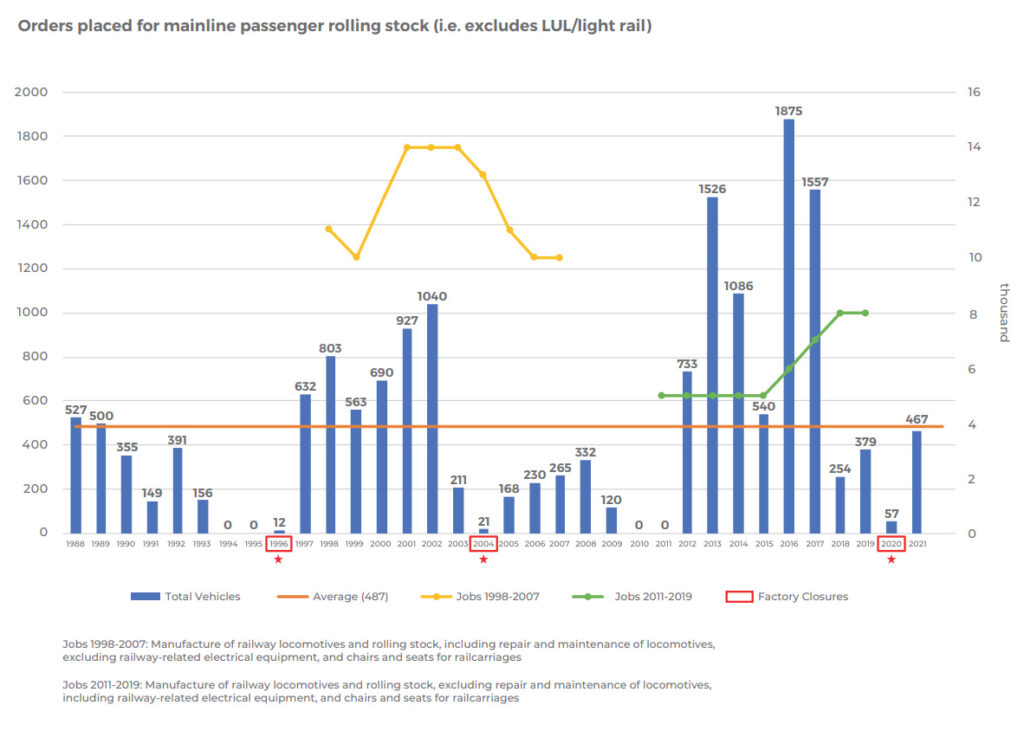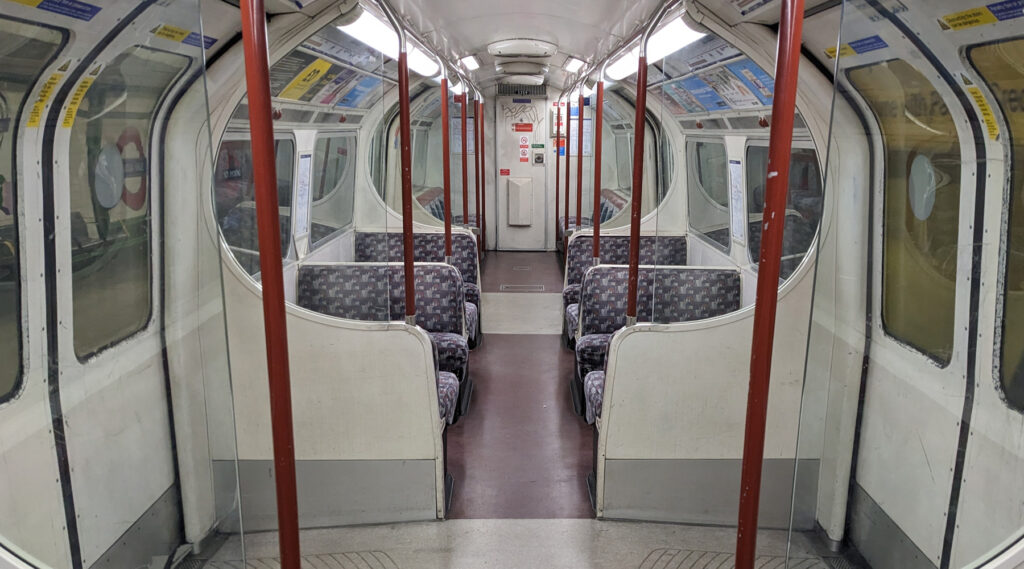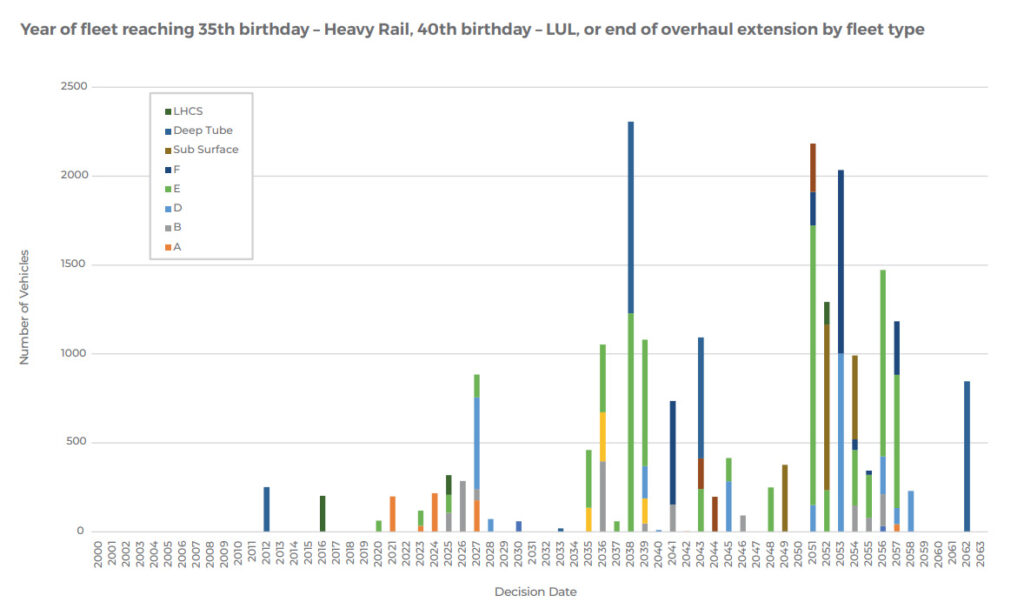A new report from the Railway Industry Association (RIA) has shown that unless action is taken now on rolling stock orders for the upgrade or replacement of the oldest trains on the railway, thousands of jobs and decades of experience will be at risk of being lost.
The issue is that despite a surge in orders for new trains between 2012 and 2017, during which half the UK’s trains were replaced, the order book has been quite low ever since, and in less than a year, the major train factories in the UK will start to run out of work.
With train orders often taking years to complete, placing orders now, or at the very least, making the commitment to place orders soon will ensure the factories aren’t closed down.
It’s not just the jobs and experience at risk, as naturally, passengers aren’t too keen on older trains either, so replacing older rolling stock is a necessary element in the railway’s post-pandemic shift to more leisure and off-peak travel.
Although the average age of the UK’s trains is just under 17 years old, that masks a number of hotspots where passengers are travelling in trains that can be more than 40 years old.
Some of the oldest in the UK are on Merseyrail, which averages over 42 years old, and despite the regular complaints about London getting all the investment, it also has the oldest EMU trains in the UK — the 50 year old Bakerloo line trains.
One of the biggest issues faced by the train manufacturers is a tendency for the government to go into feast/famine mode when authorising orders for new trains. Since 1988 there have been three periods of high orders and three famines when orders were low. It makes much more sense for everyone to have a longer term framework where the orders are more regularly spaced out to avoid delays due to overflowing order books, but also job cuts when orders are cut.
One of the peculiarities of the rolling stock in the UK is that most of the trains are privately owned by leasing companies, but the orders to buy or upgrade trains have to come from the train companies, who aren’t allowed to order trains without permission from the Department for Transport (DfT). So while the costs of new trains won’t have any impact on the taxpayer, it’s still the government making the decisions.
The RIA report recommends that orders for new trains and upgrades should be confirmed for at least any rolling stock that will be 35 or more years old by 2030.
That would lead to an order book for the train manufacturers of around 440 trains per year. That’s marginally higher than the current famine state of the order book, so not a feast, but more importantly, it gives a reliable plan for the next 6 to 8 years which means everyone knows what their financial commitments will be.
The report highlights as in need of urgent decisions a replacement or upgrade programme for over a thousand existing commuter diesel trains, plus a view on replacing a further 555 long distance diesels that will be 24 years old in 2040.
The report also says that the government should restart the procurement to replace the 588 Southeastern trains, and consider options for at least 500 more to be ordered.
And make a decision about the oldest EMU trains in the UK — the 50 year old Bakerloo line trains on the London Underground. There is a plan to replace them with the same trains currently being built for the Piccadilly line, but its unfunded at the moment. Therefore it’s important for the government to make the commitment to replace them, even if the smallprint about the funding is settled later. That commitment ensures that Transport for London (TfL) has clarity about its maintenance routine for the existing trains over the next few years, and that the manufacturer, Siemens Mobility has clarity for its Yorkshire workforce that will be building the tube trains.
While the report calls for urgent decisions on replacing the oldest of the UK’s trains, as even young trains eventually age, it’s also calling for a longer term strategy for the entire industry for the replacement and upgrade plans for middle-aged trains that will be old in the 2040s.
That could be a mix of upgrading trains to keep them running, replacement with new trains, and also a cascade system where middle-aged trains are refurbished and moved to less intensive railway lines.
The report assumes that a final decision on the future of a vehicle will be made when it is around 35 years old (40 years for tube trains) on average. It is also assumed that a vehicle will have a major refurbishment on average at around half that age at, say, 15 to 20 years old.
Based on that assumption, and the current way of replacing trains, there’s going to be more years of feast and famine ahead, with some good years in the later 2020s, 2030s and early 2050s — and some bad years in between.
Those spikes are somewhat baked in at the moment, because if you order lots of trains at once, they naturally need refurbishment or replacement at the same time in the future. A better strategy would help to smooth out those curves so there’s more reliable work for the manufacturers. It might mean bringing forward some refurbishments a few years earlier to spread the workload, or more likely, delaying some of the work where possible to even out the demand on the factories.
Their estimate is that smoothing the spikes in orders would mean a reliable workload of around 150-200 vehicles in each of the UK’s existing railway factories per year, rather than fallow years followed by overflowing order books when an occasion big order is placed.
However, unless some decisions are taken soon, despite the need to replace trains soon, there’s a risk that one or more of the UK’s existing train manufacturing factories will have to close due to a lack of work.
Commenting, RIA Technical Director David Clarke said: “With the last mainline order being over three years ago and no visibility of new orders for upgrading or renewing rolling stock in the UK, we are once again facing the prospect of job losses and factory closures.
“These closures would have a deeply damaging impact, with jobs, passenger satisfaction, value for money and the drive to decarbonise all undermined by the upcoming trough in the ‘boom-and-bust’ funding cycle.
“This RIA report is clear that rolling stock orders are required now. These should be ‘no-regrets’ decisions for Government as they wouldn’t require upfront taxpayer investment but would result in a broad range of benefits, from retaining jobs to immediate carbon and air quality improvement and a better experience for passengers”.
The report is here.










Arguably a the government could stipulate that wherever possible for new trains orders the majority should be built within the UK, as per the new Piccadilly line stock. That way they could justify signing off the spending by stating that it’s being mainly built in the UK, and presumably employing more British workers than if constructed abroad.
Hopefully they’ll give the go-ahead sooner rather than later for additional tube trains. The Bakerloo line trains have the worst speakers in the carriages. Airconditioning would be particularly welcome during the summer months.
Conversely, a government could place an order with a cheaper supplier somewhere else and argue it is saving money.
I don’t think the words ‘UK government’ and ‘long-term planning’ are very often found in the same sentence unfortunately.
Never a truer word said.
Southeastern are atrocious, with the networkers limping along on many metro routes. The government just wants to claw it’s money back from southeasterns mismanagement and it’s the customer that is suffering. I’m cycling to Datford now because services past here have become expensive, sparse and unreliable.
For all the political machinations about money, it’s this kind of nonsense that ends up making the whole industry more expensive.
Factory closures mean loss of machinery, capacity and most importantly skills which cost enormous sums to replace, and thus future trains more expensive.
And ntique trains rolling around cost ever increasing sums to maintain and keep in service.
None of it makes financial sense, but then politics rarely does, unless it suits the politicians….
The networkers are now the oldest train in the southeastern fleet they were launched back in 1992 replacing the old toast rack slam door trains I have seen new rolling stock in gravesend and dartford but what’s very annoying is that the semi fast service to charing Cross nolonger operates from gillingham instead it’s a Thames link train that stops at most stations and takes forever to get to London Bridge I usually change at gravesend or dartford to go to Waterloo East I never used to have to do that bring back the semi fast to charing Cross from Medway and axe the Thames link that’s my opinion
One problem is that the networkers are light weight. This means they perform well and use less electricity.
A new train will be heavier to comply with new saftey standards. If it is to keep up with the current timetable it will need much more powerfull traction motors. The lineside transformers will need to be upgraded to supply the additional electricity.
I feel like if they are going to upgade them they should hold off untill they can have all of the technology that is needed in this busy region:
-Moving block signalling
-Driverless
-Longer trains with a mix of SDO and longer platforms
-A PIS system that tells you which carriage to get on for your destination rather than the frantic scramble upon arrival we get on the thameslink trains.
I don’t think trains will ever be driverless. Firstly you’d never get it past the unions and secondly it would be extremely costly to put in place all the necessary upgrades to platforms/track/trains.
Worth noting on the East Coast mainline they’ve been upgrading the power supply, with London to Doncaster completed back in 2020. I believe work on the Doncaster to Edinburgh stretch is still ongoing.
Also on that line between King’s Cross / Moorgate and Grantham digital signal is being fitted. It looks like ETCS won’t start being rolled out until 2025, though I believe is already in use in the Thameslink core section. (This does cause problems for heritage trains, most of which don’t have ETCS retro-fitted.)
Given the length of time involved with these projects I doubt they can afford to wait until all infrastructure upgrades in place before these trains are replaced. That said if potential upgrades are known about then trains could be built to support / be compatible with those features in the future.
Bakerloo trains are fine for me.
Sounds like buying trains to keep people in jobs.
Would make more sense to invest in/support the train manufacturing companies to make them more competitive and therefore able to bid for overseas contracts.
What’s wrong with buying trains to keep people in jobs? Do you want people to be unemployed?
These 50 yr old trains are fine, more comfy than most modern ones and perfectly presentable. Why replace them just to keep up with the times?
They’re falling apart internally, the cost of keeping them running is ruinous, and they need special expemptions from complying with disability access requirements because they can’t be modified to comply — so people with disabilities will keep struggling to use them until decent trains are built.